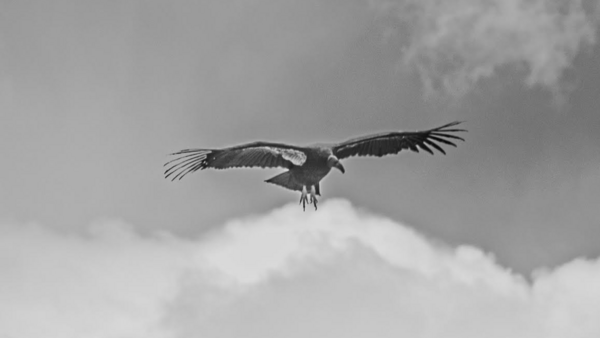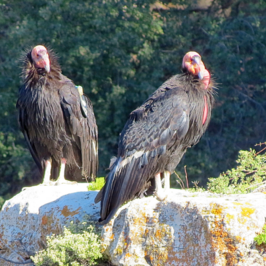Saving the California condor
“In our hands now lies not only our own future, but that of all other living creatures with whom we share the Earth.” — David Attenborough
By DR. CAMERON BARROWS
In early November of 1805, after traversing much of North America, the Corps of Discovery Expedition finally reached the shore of the Pacific Ocean at the mouth of the Columbia River, and Meriwether Lewis, William Clark, Sacagawea, and the other members of the Corps saw a California condor.
Condors were among the scavengers who profited from the abundant grazers and their predators that comprised North America’s Pleistocene fauna. Horses, muskox, camels, ground sloths, elk, pronghorn, bison, and mammoths were the prey, while grizzly bears, short-faced bears, dire wolves, lions bigger than today’s African lions, saber-toothed cats, and cheetahs were the predators. Condors reaped the benefits of those predators’ unfinished meals.
By the time Lewis, Clark and Sacagawea saw that condor, much of that Pleistocene fauna had disappeared. Some had moved across the Bering land bridge into Asia (cheetahs, camels and horses). Some had disappeared altogether (mammoths, ground sloths, saber-toothed cats, short-faced bears, and those large lions). Why that group disappeared when others didn’t is an unsolved mystery. Elk, bison, pronghorn, muskox, timber wolves, grizzly bears, and mountain lions still thrived. As evidenced by that early 19th century sighting at the mouth of the Columbia River, condors also continued to thrive. They, like their Andean condor cousins, likely also benefited from the occasional whale carcass that washed ashore, which might explain why this particular condor was hugging the shoreline rather than soaring above herds of elk or bison.
That was then. By 1980 there were fewer than two dozen condors left on Earth. The reasons for their precipitous decline are well documented. Land use changes had decimated the elk herds in the western states and our intolerance for sharing the planet with top predators such as grizzly bears and wolves had removed both of those predators from California, Oregon, and Washington by the early 20th century. No top predators and few herds of large grazers left, and so no “unfinished meals” for condors. The remaining condors were dying from lead poisoning, consuming lead bullet fragments left in deer shot by human hunters who lacked the skills to track and locate their mortally wounded prey.
California condors were on the precipice of extinction and people were at odds as to what to do. There was a vocal contingent, led by the Audubon Society, who argued that it was too late, there were too few condors left, and the reasons for their decline were too widespread to reverse. They argued to leave the remaining condors alone, to allow them to pass into extinction without the indignity of being captured and put into cages. Others argued the opposite path, that we needed to marshal whatever resources we could to save this majestic, largest flying bird of North America. That is the argument that won the day, and the reason we have condors on this planet today.
The first task was to capture those remaining wild condors. That task was spearheaded by a close friend, Dr. Peter Bloom. He employed a technique first developed by indigenous people to capture eagles for ceremonial uses. The trap was simple and effective. Dig a pit and create a roof of fallen branches and grass. Then place an animal carcass (in modern days usually a road-killed deer, or a still-born calf from a local dairy) adjacent to the pit. Traditionally the indigenous person, and more recently Dr. Bloom, would wait hours and hours in the pit until the eagles and condors would deem the carcass safe and then land and begin to feast. Multiple condors and golden eagles often arrived at the carcass together, the eagles benefitting from the condors’ superior sense of smell and vision and so their ability to locate prey. As the birds jostled around the carcass, eventually one would be adjacent to the pit, facing the carcass with their back toward the pit. At that point Pete would reach out and grab the bird’s legs and pull them into the pit and secure their wings and put a hood on the bird which immediately calmed them down. The other remaining birds seemed to barely notice their companion’s disappearance and if multiple condors were present Dr. Bloom might catch them all. Eventually he did catch every last wild condor. Each was treated for lead poisoning and then all were placed in one of the breeding programs run by the Peregrine Fund’s World Center for Birds of Prey, Los Angeles Zoo, San Diego Zoo and Safari Park, and Oregon Zoo in the U.S., and Chapultepec Zoo in Mexico City, Mexico.
Today (2023) there are 561 California Condors alive on Earth. Of those, 347 are living free among five different populations. The rest are part of the captive breeding population that is still necessary to support those wild birds. Of the known mortalities of wild birds since captive-bred birds have been released to be wild, 50% (126) have died from lead poisoning. Of the five populations, the newest one is centered on Redwood National Park (eight individuals). The other populations are centered on Pinnacles National Park in central California (94 individuals), Southern California (89 individuals), Grand Canyon-Zion National Parks (116 individuals), and Baja California (40 individuals).
One of the best indicators of success when restoring a wild population is successful breeding within that wild population. In 2023 there were nine known wild birds hatched throughout their current range (compared with 31 – so far – releases of captive-bred birds.)
Last week I visited Grand Canyon National Park along with a couple of our UC Riverside Palm Desert California Naturalists. Walking along the canyon rim, one of those juvenile condors, wild-hatched in 2023, repeatedly flew above us, dwarfing the turkey vultures and a zone-tailed hawk (that was trying its best to convince the resident ground squirrels that it was just another turkey vulture so they might let their guard down). There is a thrill seeing a condor, a bird with a nine-to-ten-foot wingspan that was on the brink of extinction just a few decades ago. A bird that, because of its size, seems to defy the laws of aerodynamics as it so gracefully and expertly navigates every nuance of the updrafts along the cliff edge. And a thrill seeing a bird that has always been wild, without the tags that decorate captive hatched and released birds. With my ever-present binoculars draped around my neck, other park visitors asked me if I had seen a condor and how and where they might see one. The anticipation and thrill of seeing a condor was not limited to we California Naturalists, it was palpable among many of the park’s visitors. Bringing the condor back from the brink of extinction was not without considerable monetary cost. However, it serves as an example of what we are capable of, righting the wrongs resulting from our lack of understanding and awareness of our negative impacts on the natural world we depend on. It was well worth it.
I once asked a Grand Canyon park ranger if he had any hypotheses as to why the condors often spend so much time in the very same areas of the park where people congregate. He thought a moment and said that for a condor, going back in time, they followed large herds of elk, or camels or horses, knowing that if they waited long enough, eventually the sick and weak would succumb to a predator, and then the leftovers would be available to the condor. For a condor those aggregations of people along the canyon rim are just herds, and they are patient birds.
Of the below photos, the black-and-white image is of that wild-hatched juvenile we saw last week. It was taken by Charles Bemis – one of those California Naturalists. The color photo is from my collection over the past few years.
Nullius in verba
Go outside, tip your hat to a chuckwalla (and a cactus), think like a mountain, and be safe.

